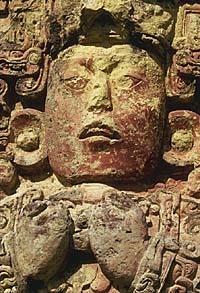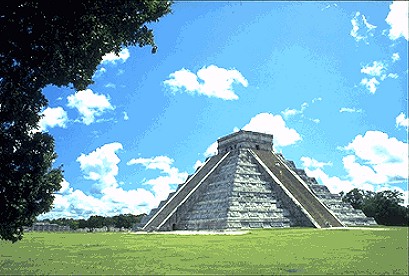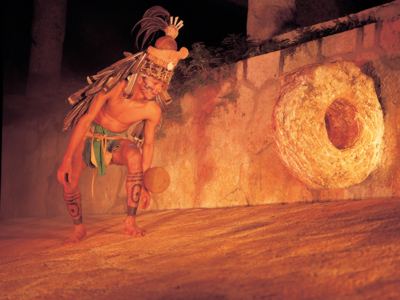|

The Maya are probably the best-known of the classical civilizations of Mesoamerica. Originating in the Yucatán around 2600 B.C., they rose to prominence around
A.D. 250 in present-day southern Mexico, Guatemala, northern Belize and western Honduras.
Building on the inherited inventions and ideas of earlier civilizations such as the Olmec, the Maya developed astronomy, calendrical
systems and hieroglyphic writing. The Maya were noted as well for elaborate and highly decorated ceremonial architecture,
including temple-pyramids, palaces and observatories, all built without metal tools. They were also skilled farmers, clearing
large sections of tropical rain forest and, where groundwater was scarce, building sizeable underground reservoirs for the
storage of rainwater. The Maya were equally skilled as weavers and potters, and cleared routes through jungles and swamps
to foster extensive trade networks with distant peoples.

Around 300
B.C., the Maya adopted a hierarchical system of government with rule by nobles and kings. This civilization developed into
highly structured kingdoms during the Classic period, A.D. 200-900. Their society consisted of many independent states, each
with a rural farming community and large urban sites built around ceremonial centres. It started to decline around A.D. 900
when - for reasons which are still largely a mystery - the southern Maya abandoned their cities. When the northern Maya were
integrated into the Toltec society by A.D. 1200, the Maya dynasty finally came to a close, although some peripheral centres
continued to thrive until the Spanish Conquest in the early sixteenth century.

Maya history can be characterized as cycles of rise and fall: city-states rose in prominence and fell into decline,
only to be replaced by others. It could also be described as one of continuity and change, guided by a religion that remains
the foundation of their culture. For those who follow the ancient Maya traditions, the belief in the influence of the cosmos
on human lives and the necessity of paying homage to the gods through rituals continues to find expression in a modern hybrid
Christian-Maya faith.
|
Maya history
Scholars and archeologists divide the
Maya development into three main periods for over 2,500 years. This Mesoamerican civilization covered a vast territory and
reached its zenith between 250-900 AD in present-day south-eastern Mexico, Belize, Guatemala and Honduras.
Their legacy includes some of the finest jewels in todays world of archeology: Palaces, Observatories, Temple-pyramids and
Ceremonial sites. Many of these sites are still, over a thousand years later, in excellent conditions for you to discover
and explore.
PreClassic Period (1500 BC-250 AD)
This is the Formative period
during which the population grew, the agriculture developed new techniques and rulers evolved from probably powerful spiritual
leaders. Early Maya ceremonial centers emerged in the lowlands and PreClassic rulers consolidated their power and centralized
authority.
Classic Period (250-900 AD)
The Classic period was characterized by the emergence
of city-states ruled by powerful kings who adopted a hierarchical system of government. Astronomy, medicine and writing were
developed. These large urban states were built around ceremonial centers and covered extensive areas of land. We owe to this
period some of the greatest archeological marvels known to us and built by this astonishing civilization.
PostClassic Period (900-1200
AD)
The Maya decline began around 900 AD with governments
becoming highly segmented and for reasons largely unknown to us, the Maya abandoned their cities in the south. The northern
Mayas were finally integrated in the early thirteenth century by the Toltecs who dominated central Mexico
from the city of Tula. Some smaller centers continued to thrive
until the Spanish conquest of Mexico in
the early sixteenth century.
MAYA CHRONOLOGY
11,000 B.C.
The first hunter-gatherers settle in the Maya highlands and lowlands.
3113
The
creation of the world takes place, according to the Maya Long Count calendar.
2600
Maya civilization
begins.
2000
The rise of the Olmec civilization, from which many aspects of Maya culture are derived.
Village farming becomes established throughout Maya regions.
700
Writing is developed in Mesoamerica.
400
The earliest known solar calendars carved in stone are in use among the Maya, although the solar
calendar may have been known and used by the Maya before this date.
300
The Maya adopt the idea of a hierarchical
society ruled by nobles and kings.
100
The city of Teotihuacan is founded
and for centuries is the cultural, religious and trading centre of Mesoamerica.
50
The Maya city of Cerros is built, with a complex of
temples and ball courts. It is abandoned (for reasons unknown) a hundred years later and its people return to fishing and
farming.
100 A.D.
The decline of the Olmecs.
400
The Maya highlands fall under the domination of Teotihuacan,
and the disintegration of Maya culture and language begins in some parts of the highlands.
500
The Maya
city of Tikal becomes the first great Maya city, as citizens from Teotihuacan
make their way to Tikal, introducing new ideas involving weaponry,
captives, ritual practices and human sacrifice.
600
An unknown event destroys the civilization at Teotihuacan,
along with the empire it supported. Tikal becomes the largest city-state in Mesoamerica , with as many as 500,000 inhabitants
within the city and its hinterland.
683
The Emperor Pacal dies at the age of 80 and is buried in the Temple of the Inscriptions at Palenque.
751
Long-standing Maya alliances begin to break down. Trade between Maya city-states declines, and
inter-state conflict increases.
869
Construction ceases in Tikal,
marking the beginning of the city's decline.
899
Tikal is abandoned.
900
The Classic Period of Maya history ends,
with the collapse of the southern lowland cities. Maya cities in the northern Yucatán continue to thrive. |
|

|
|

